BY JAMES KIRSCH
When a fire department has an acquired structure, it is important for the company officers or department training officer to prioritize what drill topics will be covered. They’ll also need to create a schedule that focuses first on the least-destructive drills and wait until later in the training period to focus on firefighter training drills that will cause greater structural damage.
- Company Drills in Acquired Structures
- Maximizing Training Evolutions in an Acquired Structure
- Getting the Most Out of Acquired Structure Live Burns
- Fire Training in Acquired Structures
Pretraining Steps
After the structure has been properly obtained; inspected; repaired as needed; and determined to be safe to operate in, on, and around, the company officers and training officers should stop by and review the property before any hands-on training starts. Here are steps for them to follow:
- Start the review at the property line and take in all exterior sides of the structure to see what the property offers that can be used as a training topic or for a hands-on skills drill.
- In this review, include all garages, other structures on the property, and items left behind that could be used as part of a training topic.
- Have as many company officers as possible do this walkaround. This enables everyone involved to share more ideas and experiences.
- Repeat this process for the main structure.
- Always confirm that any off-limit areas to be drilled on are well-known and marked off as required. (Consider using fire line caution tape.)
Hands-on Skills Topics
Once you’ve taken the pretraining steps above, think through your next steps, depending on what’s available to you. The topics that follow will give you an idea of how different elements of an acquired structure will help your department with training.
Topic 1: Rails
In photos 1 and 2, these firefighters use a training dummy put through a handrail as a prop to work with air bags and hydraulic tools to remove the “victim.” This outside rail can also be used as a knot-tying station and as a cutting prop for tool familiarization on reciprocating saws, air-powered cutting tools, and roof saws using metal cutting blades, both gas and battery powered.


1 & 2. Firefighters use an exterior handrail as a prop to practice removing the “victim” with air bags and by working with hydraulic tools. (Photos by author.)
Topic 2: Outside the Structure
Officers must keep an open mind when they consider what the property might offer. It’s important to think beyond structure-damaging drills inside the acquired structure. In photo 3, the exterior offers several training topics that could be quick discussions. But, depending on your department’s needs, the discussions might be more involved and equipment oriented. The building allows for ladder placement (aerial or ground) and the glass door near the center of the photo will allow for a through-the-lock forcible entry drill, but what else could you cover?
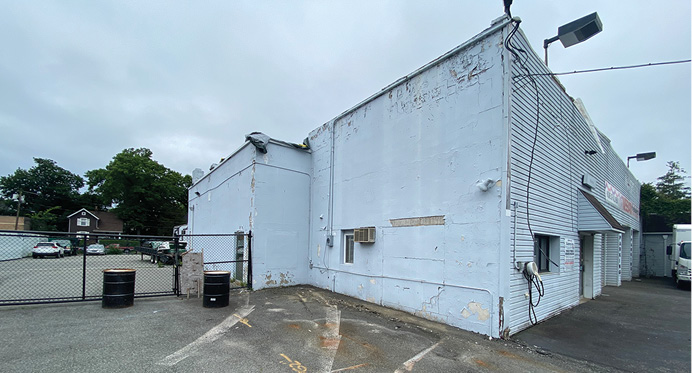
3. This exterior view of an acquired structure shows many training topics that can be discussed if the officer doesn’t walk past them to concentrate on the interior of the building.
As we go from left to right through photo 3, key topics to discuss include the following:
- The chimney (clogged, unstable, or weakened).
- Damage to the roof covering, which appears to be lifting off.
- The location of the drain scupper to determine the height of the parapet.
- The chain-link fence and how we would go around it; over it; or, if needed, remove it.
- A hazardous materials discussion on the metal drums and what the standard operating procedures are for abandoned or leaking drums.
- Electrical hazards and sparking and arcing issues from electrical meter pans and conduit and hanging wires, plus the older-style electric vehicle charging unit on the far right of the photo.
Topic 3: Routine Calls
These structures also allow us to train our newer members who may not yet have a lot of hands-on experience with what would be considered a department’s more routine calls. These could include investigating and resetting activated fire alarms and being called out for odor investigations, sometimes referred to as “smells and bells.”
An acquired structure also makes it possible for several members at the same time to take electrical outlets apart and practice making them safe, based on the topic of a caller reporting an odor or smoke from the electrical outlet (photo 4).
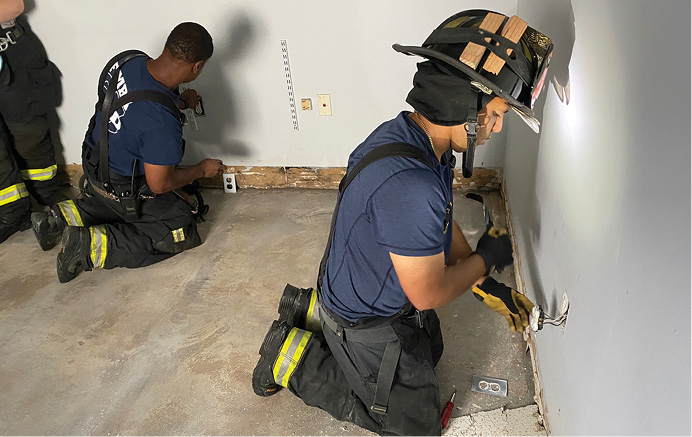
4. By assigning an electrical outlet to each member, several firefighters can work at the same time in the same room on properly taking apart electrical outlets.
This building’s fluorescent light fixtures (photo 5) offer a good place for practicing removing light ballasts. The company officer should make sure all steps are covered as needed, from using circuit testers to tracing circuits back to the breaker panel and confirming that the power for the correct area was turned off.
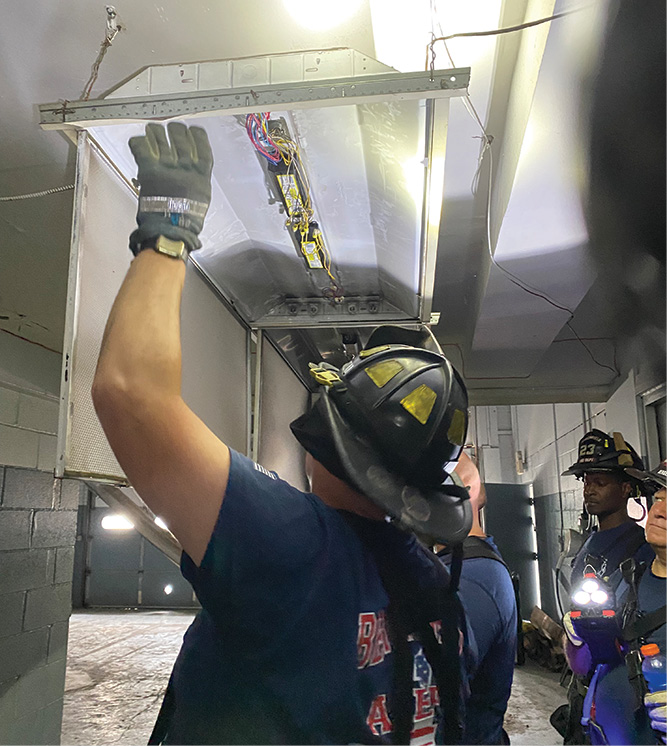
5. Here, members are getting experience removing fluorescent light ballasts and taking light fixtures apart.
Topic 4: Getting to Know the Company
Company officers need to know what their members’ knowledge and skill levels are. They need to address the age-old dilemma of “You don’t know what you don’t know.” While this may not be a problem for a company officer who has worked with the same personnel for years, it’s an issue that needs to be addressed for the newly assigned officer or for the seasoned officer getting new recruits.
Topic 5: Setting Drills
Acquired structures are ideal for setting the drills that can determine everyone’s skill set. If, during an odor investigation or a check for fire extension, the officer makes a request to trim the wall or window molding and sash weight during overhaul, the officer doesn’t want to return to find the entire wall removed. Departments can use acquired structures to practice this and other overhaul lessons.
In part, these are set up to confirm that rookie firefighters know how and where fire will travel through the structure. The use of visual aids should help get the point across (photo 6). And, as the soil pipe chase is usually the largest avenue for fire spread to the upper floors and attic space, it should also be included in the practice of opening up (photo 7).
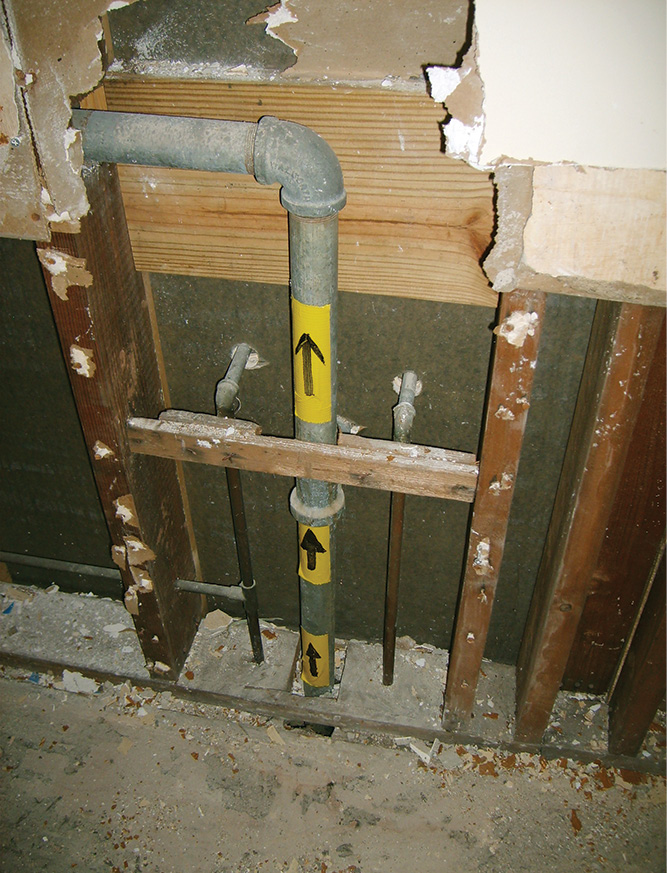
6. Probationary and rookie firefighters must understand fire spread and how to properly open up to check for extension. Visual aids such as arrows on pipe chases and showing the opening between floors indicated by the pike pole can help.
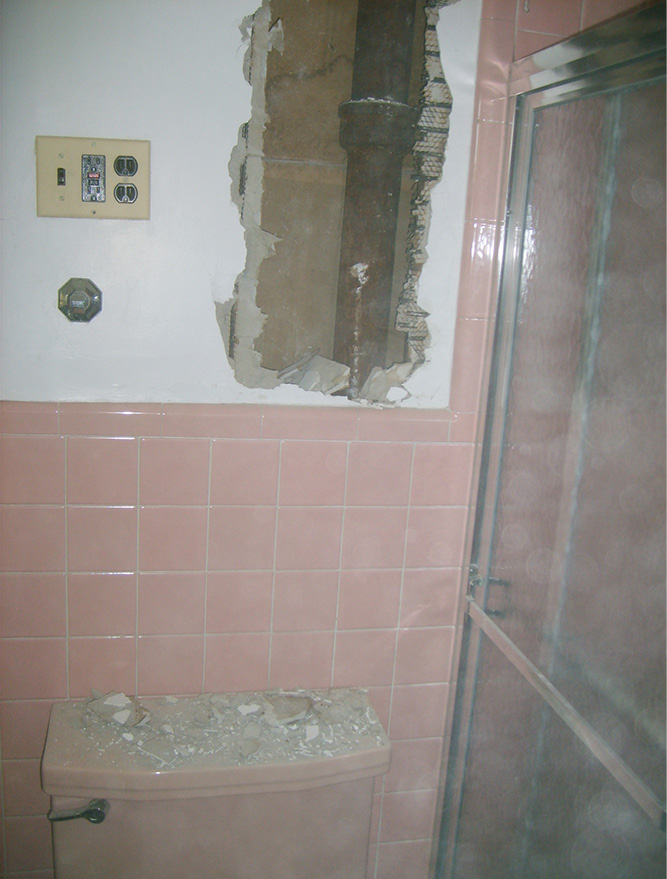
7. The role of the soil pipe in fire extension is critical. Enclosed soil pipe chases in donated structures should be opened, so the firefighter understands its importance when discussing fire spread.
Topic 6: Rescue and Response
Another worthy training opportunity is using the donated building to practice the rescue and removal of injured or unresponsive firefighters.
In one demonstration, firefighters use several sets of closet doors with the hinges left on so they can be nailed together on each side of the window that will be used to remove the firefighter.
The doors closest to the trimmed window have their hinges nailed into place at the window. Firefighters have removed the windowsill to allow for the closet doors to be flush with the wall. They’ve also trimmed floor molding in this room and nailed it in place across the top to give the doors rigidity so it remains in place while the company members practice with a Denver drill-inspired prop (photo 8). An added benefit to this drill is that it used what was available in the building at no cost and without the need to bring prop-building supplies to the building.

8. Using closet doors and other items found in this donated house, the firefighters can practice with a type of Denver drill prop.
In another demonstration, we are looking at a way to remove a firefighter from a hole in a damaged roof deck. For the firefighter falling through the weakened roof decking, this drill has the rescuing firefighters deploy a roof ladder on either side of the trapped member. The idea here is that with this moderately pitched roof already being in poor condition, the firefighter in the hole can use ladders to assist in self-removal or, if needed, the rescuing firefighters can stay off the damaged decking by climbing up the ladders.
The use of a pike pole through the self-contained breathing apparatus allows the firefighters to lift the trapped member up and out of the hole. A word of caution when practicing this maneuver: Have the firefighters move in the direction of the ridge pole. This way, if any of the firefighters doing the lifting lose their balance, they will fall into the roof. If firefighters lose their balance while attempting to first move toward the gutter line, they could fall off the roof (photos 9 and 10).
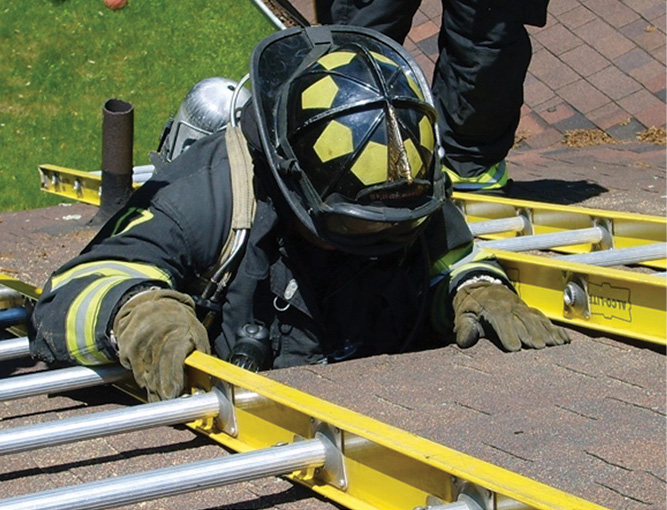
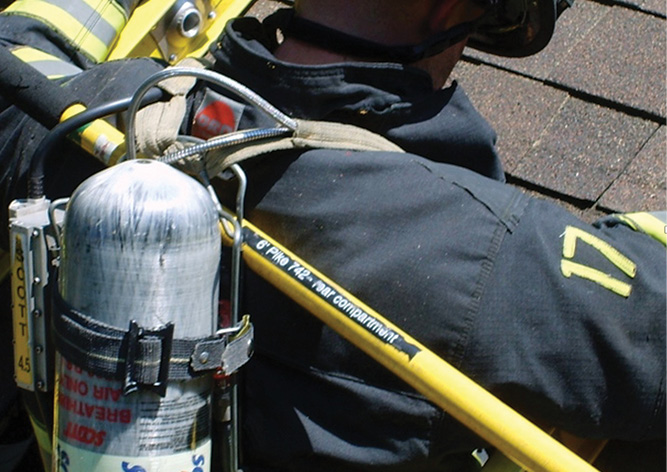
9 & 10. Firefighters practice removing a trapped member from damaged roof decking. When using this method, it is important to move up toward the ridge pole after lifting the firefighter out of the hole so no one falls down the roof.
Topic 7: Keeping Old-School Skills Fresh
Acquired structures are good places brush up on using older tools that may be in the back of the firehouse or stored on a reserve piece of apparatus.
If a tool is in your firehouse, you should know its role on the fireground and be comfortable using it. Good examples of “old-school” tools that today’s firefighters should be comfortable with are the cellar pipe (photo 11) and Detroit door opener (photo 12). One reference source that can help with this is the book Tools of the Trade: Firefighting Tools and Their Use. 1

11. Acquired structures are good places to practice with older tools and appliances. Here, firefighters are setting up a cellar pipe.

12. Firefighters get ready to practice with a Detroit door opener.
Topic 8: Responding to Heavy Smoke
If your department can hold live fire exercises in a donated property (following NFPA 1403, of course), use the property to its maximum before burning it down. The use of artificial smoke to fill the structure to get members comfortable in a heavy smoke condition can be a safer and more controlled alternative than working with less experienced members under a real fire condition.
In addition to concerns of firefighters contracting cancer, another issue that has come up more in recent years is the increased risk of exposure to carcinogens and their effects during multiple training burns, even when using class A products.2 Consider training with artificial smoke before exposing firefighters, officers, and instructors to multiple days of live fire drills in real smoke conditions.
ENDNOTES
1. Fritz, Richard A., and Ciampo, Michael N., Tools of the Trade: Firefighting Tools and Their Use, Fire Engineering Books, 2nd Edition, 2017.
2. Fent, Kenneth W. et al, “Firefighters’ and Instructors’ Absorption of PAHs and Benzene During Training Exercises,” International Journal of Hygiene and Environmental Health, Volume 222, Issue 7, August 2019, pp. 991-1,000.
JAMES A. KIRSCH served for 31 years with the Bergenfield (NJ) Fire Department, where he retired as a captain. He is also a former volunteer chief and department training officer and served as a logistics manager for New Jersey Task Force 1 Urban Search & Rescue. Kirsch is a New Jersey state-certified drill ground instructor, incident manager, and fire prevention official. He has authored multiple articles for Fire Engineering, co-authored Fire Engineering’s Study Guide for Firefighter I and II, and created the DVD Live Fire Training in Acquired Structures. Additionally, he consults for the NJ Motion Picture and Television Commission on production fire safety. Kirsch has a master’s degree in public administration and is a graduate of the National Fire Academy’s Executive Fire Officer program.

